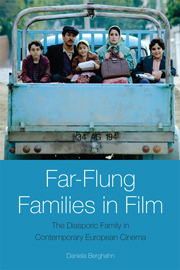Book contents
5 - Romance and Weddings in Diaspora
Published online by Cambridge University Press: 05 September 2013
Summary
At the end of Moonstruck, a romantic comedy set in Brooklyn, the lovers Loretta Castorini and Ronny Cammareri finally get together. Ronny's proposal of marriage takes place in the kitchen of the extended Italian American Castorini family, who have congregated around the breakfast table. Not only is a new couple created but also an old couple is reunited, as Loretta's mother insists that her husband Cosmo give up his mistress, reminding the self-pitying philanderer: ‘Your life is not built on nothing. Te amo’. Cosmo confesses his love in return, lifts his glass and toasts, ‘A la famiglia’, thereby re-affirming that love is the foundation of the family. The camera pans away from the scene in the kitchen into the adjacent room, as if searching for material evidence of what actually constitutes a family. A slow tracking shot explores the family heirlooms, old china stored in glass vitrines, pieces of antique furniture and some paintings, a still life and a sepia-coloured picture of the Holy Family. Finally, the camera comes to rest on a collection of black-and-white family photos on a chest of drawers, which capture the memorable moments of family life: a small child, two little girls proudly holding their new dolls under a Christmas tree, a woman showing off an elegant dress and a man against the backdrop of what looks like an Italian landscape. Then it zooms in on a large hand-coloured photograph of an ancient couple, presumably the family matriarch and patriarch, looking straight into the camera.
- Type
- Chapter
- Information
- Far-Flung Families in FilmThe Diasporic Family in Contemporary European Cinema, pp. 152 - 185Publisher: Edinburgh University PressPrint publication year: 2013

